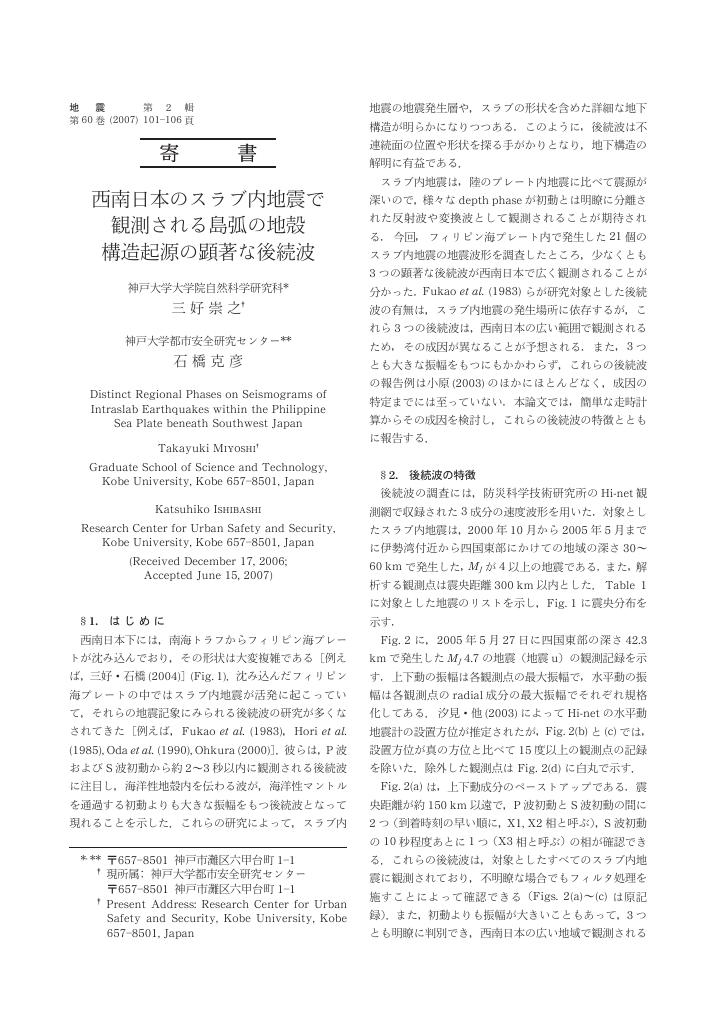1 0 0 0 東海地震を予告するデ-タ
- 著者
- 石橋 克彦
- 出版者
- 朝日新聞社
- 雑誌
- 科学朝日 (ISSN:03684741)
- 巻号頁・発行日
- vol.37, no.1, pp.p59-67, 1977-01
- 著者
- 石橋克彦
- 雑誌
- 京都大学防災研究所研究集会13K-7報告書
- 巻号頁・発行日
- pp.1-9, 2002
- 被引用文献数
- 1
1 0 0 0 OA 大正10年竜ケ崎地震の震源位置について -アーツ1号が発見した「線」との関連- (速報)
- 著者
- 石橋 克彦
- 出版者
- 公益社団法人 日本地震学会
- 雑誌
- 地震 第2輯 (ISSN:00371114)
- 巻号頁・発行日
- vol.26, no.4, pp.362-367, 1973-12-30 (Released:2010-03-11)
- 参考文献数
- 11
- 著者
- 石橋 克彦
- 出版者
- 岩波書店
- 雑誌
- 科学 (ISSN:00227625)
- 巻号頁・発行日
- vol.81, no.5, pp.411-416, 2011-05
1 0 0 0 対談 迫り来る原発震災の恐怖
- 著者
- 石橋 克彦 村田 光平
- 出版者
- 岩波書店
- 雑誌
- 世界 (ISSN:05824532)
- 巻号頁・発行日
- no.741, pp.218-225, 2005-07
1 0 0 0 「原発震災」が襲う (特集 核からの脱却)
- 著者
- 石橋 克彦
- 出版者
- 宇都宮軍縮研究室
- 雑誌
- 軍縮問題資料 (ISSN:02870177)
- 巻号頁・発行日
- no.214, pp.26-31, 1998-08
1 0 0 0 原発震災--破滅を避けるために
- 著者
- 石橋 克彦
- 出版者
- 岩波書店
- 雑誌
- 科学 (ISSN:00227625)
- 巻号頁・発行日
- vol.67, no.10, pp.720-724, 1997-10
- 被引用文献数
- 1
1 0 0 0 大地震直撃地に集中する原発 (原発震災と日本列島)
- 著者
- 石橋 克彦
- 出版者
- 公益社団法人 日本地震学会
- 雑誌
- 地震 第2輯 (ISSN:00371114)
- 巻号頁・発行日
- vol.72, pp.69-89, 2019 (Released:2020-01-31)
- 参考文献数
- 92
In leap July of the 5th year of Bunroku (in the old Japanese calendar; mostly September, 1596 in the Gregorian calendar) Bungo province (present-day Oita Prefecture) in Kyushu, southwest Japan, suffered from severe earthquake and tsunami disasters. Concerning the occurrence date of the causative earthquake, the prevailing idea is currently that a large earthquake took place on leap July 9 (September 1, 1596) in Iyo province (present-day Ehime Prefecture) in Shikoku, on the eastward opposite shore of Bungo, and another large earthquake occurred on leap July 12 in Bungo. Against this idea, I claim that a single event which can be called “the Iyo-Bungo earthquake” occurred around seven p.m. on leap July 9 in the Iyo-Bungo region based on reliable contemporary historical records. There are 69 documents on this (these) earthquake(s) printed in the existing collections of historical earthquake materials, but their values as historical records vary considerably. Since the essential principle of historiographical seismology is to utilize only reliable first-grade documents, I performed historical source criticism to select 16 contemporary materials. I referred to their original or best texts, not using texts printed in the collections. According to a record in Bungo violent ground motion collapsed shrine buildings around seven to nine p.m. on leap July 9 and a large tsunami hit Fuchu (Oita) in the twilight. In Kyoto, an autograph diary of a court noble, which is used for the first time in historical seismology, describes considerable earthquake motion around seven p.m. on leap July 9. In Hiroshima Prefecture, at Hatsuka-ichi and Itsukushima strong ground motions were felt at night on leap July 9 without damages, and at Mihara strong tremors continued from leap July 9 till 12. In Iyo, a contemporary record says a severe ground motion occurred on leap July 9 and the whole Iyo province had trouble, suggesting earthquake damages in a wide area. In Satsuma and Osumi provinces (present-day Kagoshima Prefecture), a record tells a strong earthquake on leap July 9. As a fundamental methodology of historiographical seismology, these tremors and tsunami in Bungo, Iyo, Kyoto, Hiroshima and Kagoshima on leap July 9 are considered to have been produced by an identical earthquake unless there is any counter-evidence. Leap July 12, the other proposed date of the Bungo earthquake, comes from historical materials written after 1698, which probably mistook the great Kyoto earthquake in the midnight of leap July 12 for the Bungo event. Seismic intensities are estimated to be 6 in Bungo, stronger than or equal to 5 in Iyo, 4 in Hiroshima Prefecture, 3 in Kyoto, and about 4 in Kagoshima on the JMA scale (1949-1996 version). The most simple and reasonable interpretation is that a large earthquake with the source region from around Beppu Bay off Bungo to the offshore area of western Iyo, a part of the Median Tectonic Line fault zone, took place around seven p.m. on leap July 9, whose inferred magnitude being about 7.5 (corresponding to MJMA), and the tsunami on the Bungo coast followed.
1 0 0 0 1293年永仁鎌倉地震と相模トラフ巨大地震の再来時間
- 著者
- 石橋克彦
- 雑誌
- 地震学会1991年秋季大会講演予稿集
- 巻号頁・発行日
- vol.251, 1991
- 被引用文献数
- 1
1 0 0 0 大地動乱の時代 : 地震学者は警告する
1 0 0 0 南海トラフ巨大地震 : 歴史・科学・社会
1 0 0 0 OA 多層構造モデルのもとで多点のS-P時間をもちいた古い地震の震源再計算
- 著者
- 石橋 克彦
- 出版者
- 公益社団法人 日本地震学会
- 雑誌
- 地震 第2輯 (ISSN:00371114)
- 巻号頁・発行日
- vol.28, no.3, pp.347-364, 1975-10-10 (Released:2010-03-11)
- 参考文献数
- 31
- 被引用文献数
- 1
For the purpose of precise relocation of earthquakes which had occurred in Japan around the first quarter of this century, a computer program was written which calculates hypocenter parameters by the method of least squares using S-P times at more than three stations and employing an arbitrary multi-layered crustal structure.As examples of relocation, about five semi-destructive earthquakes in the Kanto district: the Ryugasaki earthquake of 1921, the Yatabe earthquake of 1922, the Mitsukaido earthquake of 1923, the Uraga Channel earthquake of 1922 and the Haneda earthquake of 1926, all near-field S-P time data were carefully examined and hypocenters were redetermined. The epicenters and the focal depths obtained are expected to be uncertain by less than ±10km except the Uraga Channel earthquake. The former three, which has been suspected to be precursory activities of the Great Kanto earthquake of 1923, were ascertained to have their origins in the upper mantle beneath the SW part of the Ibaraki Prefecture where is even now a remarkable swarm area.
1 0 0 0 歴史地震研究で感じたこと
1 0 0 0 OA 原子力発電所の地震安全性を矮小化している「基準地震動」:新たな「深層防護用地震動」の提案
- 著者
- 石橋 克彦
- 出版者
- 日本地球惑星科学連合
- 雑誌
- JpGU-AGU Joint Meeting 2017
- 巻号頁・発行日
- 2017-03-10
●はじめに: 地震の脅威を仮に地震動に限っても,原子力規制委員会による新規制基準は,原発の地震安全性の確保に関して極めて不十分である.原発の地震対策は,福島原発事故後に抜本的に再構築されるべきだったにもかかわらず,基本的に昔ながらの狭義の耐震設計とそのための「基準地震動」に矮小化されているからである.したがって,ある原発が新規制基準を満たしても(審査に合格しても),その原発の地震安全性は保証されない.しかも現在は,審査が甘く,新規制基準すら満たさずに再稼働しつつある.本発表では,新規制基準の枠内での基準地震動(以下Ss)の技術的問題点にも言及するが,より根元的に,基準地震動に替わるべき新たな想定地震動の概念を提案する.●新規制基準でのSs の問題点: 規制委員会規則第5号および「同規則の解釈」および関連審査ガイドが規定するSs と,実際に新規制基準適合性審査で承認されたSs は,年超過確率でみたとき,原発の安全目標である10-4 (炉心損傷頻度)〜10-6 (重大事故による大量放射能放出)に比べて著しく過小評価である.「震源を特定せず策定する地震動」には旧原子力安全委員会以来の方法論的欠陥があるし,「敷地ごとに震源を特定して策定する地震動」では,活断層の長さから地震モーメントを求める式の良否など以前の問題として,一般に活断層が地下の震源断層を一意的には示さないことが根本的に重要である.なお,松田 (1975) の式が今でも使われているが,石橋 (1998) 以来指摘している問題があるし,松田 (1998) で改訂もされている.また,演者が旧安全委の耐震指針改訂の際に提案した続発大余震の考慮が新規制基準に入っていないのも問題である.●狭義の耐震設計用基準地震動から「深層防護用地震動」へ: 原発事故による放射線災害から人と環境を守るための基本的考え方は「深層防護」(安全対策の多段階設定)であり,新規制基準もそれが基本だとしている.そうであれば,原発の地震安全性を確保するための地震動は,これまでのように第1層の異常運転の予防,第2層の異常運転の制御,第3層の事故を想定範囲に収める制御(ここまでが重大事故SAの防止)における設備・機器の耐震設計のためのSs として考慮するだけでは不十分である.第4層のSAの制御と影響緩和においても当然考慮されなければならない.すなわち,1万〜100万年に1度の地震に対して特定重大事故等対処施設(免震重要棟,予備電源・注水設備,可搬型設備など)や発電所内の道路なども機能を損なわないことを,厳重に確認しなければならない.九州電力川内原発を例にとれば, 水平最大加速度 540 Gal のSs-1も,同 620 Gal のSs-2も,短周期成分だけで振動継続時間が短く,米国で重視されている累積絶対速度CAV (Cumulative Absolute Velocity;佐藤, 2015) も極めて小さい.南海トラフ巨大地震が内閣府 (2012) の想定か,それ以上の規模で起これば,川内原発における短周期から長周期までの地震動の加速度,速度,変位,継続時間が第4層の設備・施設・作業を破綻させる可能性は高い.したがって,第1層から第4層までに適用される広帯域の「深層防護用地震動」(Earthquake Ground Motion for Defense in Depth, EGMDD) とでもいうべきものを新たに想定し,それに対して各層の健全性を確認する必要がある.さらに,深層防護の第5層(SAが制御できずに放射性物質が大量放出された場合の所外での緊急対応) が,(津波と地殻変動を別としても)EGMDDによって阻害されないことが,原発の総合的な地震対策の最後の砦として必要不可欠である.●国民が納得できる「深層防護用地震動」の策定を: ある原発において人々の安全と安心が得られる地震動(Ss であれEGMDDであれ)がどのようなものであるかは,地震学・地震工学によっては答が出せず,Weinberg (1972) が述べたようにトランス・サイエンスの問題である.その決定は規制委の守備範囲を超える.理学・工学専門家による検討過程,工学的対応可能性,経営的判断,住民の要求といったものをすべて持ち寄り,全関係者の討論によって,あるレベルで合意できるか,合意できずに操業をやめるか,結論を導くべきであろう.そのような場として,例えばフランスで相当程度に機能しているCLI(Commission Locale d'Information;地域情報委員会;例えば, 菅原・城山, 2010)のような仕組みをいっそう拡充・確立することが考えられる.このような取り組みをしなければ,福島原発事故を上回るような「原発震災」の再発を防げないだろう.
1 0 0 0 OA 西南日本のスラブ内地震で観測される島弧の地殻構造起源の顕著な後続波
- 著者
- 三好 崇之 石橋 克彦
- 出版者
- 公益社団法人 日本地震学会
- 雑誌
- 地震 第2輯 (ISSN:00371114)
- 巻号頁・発行日
- vol.60, no.2, pp.101-106, 2007-10-25 (Released:2013-08-20)
- 参考文献数
- 15
- 被引用文献数
- 2 2
- 著者
- 石橋 克彦
- 出版者
- 海洋出版
- 雑誌
- 月刊地球 (ISSN:03873498)
- 巻号頁・発行日
- vol.27, no.11, pp.875-881, 2005-11
1 0 0 0 OA 相模湾西部, 初島の完新世海成段丘と地殻上下変動
- 著者
- 石橋 克彦 太田 陽子 松田 時彦
- 出版者
- 公益社団法人 日本地震学会
- 雑誌
- 地震 第2輯 (ISSN:00371114)
- 巻号頁・発行日
- vol.35, no.2, pp.195-212, 1982-06-25 (Released:2010-03-11)
- 参考文献数
- 19
- 被引用文献数
- 1 1
Uplifted Holocene marine terraces of Hatsu-shima Island (0.44km2) in the western part of Sagami Bay on the Pacific coast of central Japan have been investigated with special reference to the late Quaternary seismic crustal movement of the island. Hatsu-shima Island, which is located at the top of the western steep scarp of the northernmost part of the Sagami trough, was uplifted almost uniformly by around 2m at the time of the 1923 Kanto earthquake (Ms=8.2).The whole surface of the island consists of a flight of marine terraces developed on Pliocene volcanics. These terraces are clearly classified into three groups; I, II, and III. Terrace I, the highest (about 50m asl), is distributed only in the southeastern small part of the island. Terrace II, 25-40m asl, is the widest in the island and tilting, generally, northwestward. Terraces I and II have been correlated to Obaradai Terrace of about 80, 000yrs B. P. in age and to Misaki Terrace of about 60, 000yrs B. P. in age, respectively, by SUGIHARA (1980) based on marker tephras covering the terraces.Terraces III, rather narrow but well defined especially in the northern and western parts of the island, is distributed along the present shoreline at the foot of a former sea cliff as high as about 20m surrounding Terrace II (or I in the southeastern part). In this paper they are subdivided into three; IIIa, IIIb, and IIIc. Terrace IIIa, the highest and widest among group III, is rather flat with about 10m asl inner margin. Planned excavation at three localities on this terrace has revealed that terrace deposits composed of marine gravel and sand of 1.5-2m thickness rest unconformably on rather weathered bed rock. Fossil shells that were obtained at the base of terrace deposits at Excavation B, which are judged to be in situ and to represent the terrace's age, have been dated at 6, 730±190 14C yrs B. P. (GaK-9080). From this 14C date, as well as from the topographical features, Terrace IIIa can be interpreted as the highest Holocene terrace formed about 6, 000 years ago (so-called Numa Terrace). The height of former shoreline is estimated at around 9m asl. Terraces IIIb and IIIc are narrow emergent shingle beach, whose inner margins are 6-7m asl and about 4m asl, respectively. IIIc includes the emergent beach of 1923 in its lowest part. Although the topographical separation between IIIb and IIIc is not necessarily clear, they can be distinguished from each other as IIIb surface is covered by dense vegetation including many pine trees which have been growing since before the 1923 coseismic uplift, whereas IIIc surface has no vegetation. Therefore, it is almost certain that at least two times of intermittent emergence had occurred between the formation of Terrace IIIa and the 1923 coseismic uplift. However, the dates of emergence have remained undefined, because 14C dates of fossil shells which were collected from Terraces IIIb and IIIc are so much scattered implying that the materials are not in situ. In the northern part of the island there is a prominent flat surface higher than Terrace IIIa, 10-15m asl, where Hatsu-shima village is situated. In this paper it is named IIIa' Surface and considered a secondary surface modified from Terrace IIIa by landslides of a back scarp and artificial alteration based on its sedimentological features, surrounding topographical features, and rather young 14C dates of materials obtained from this surface.
1 0 0 0 OA 1433 (永享5) 年会津地震 (M6.7) の非実在性
- 著者
- 石橋 克彦
- 出版者
- 公益社団法人 日本地震学会
- 雑誌
- 地震 第2輯 (ISSN:00371114)
- 巻号頁・発行日
- vol.36, no.2, pp.169-176, 1983-06-25 (Released:2010-03-11)
- 参考文献数
- 17
- 被引用文献数
- 3
TOKYO ASTRONOMICAL OBSERVATORY (1981) and USAMI (1975) are listing a historical destructive earthquake of magnitude 6.7 that occurred in the Aizu province in northeast Japan on November 7, 1433. However, the only basis of the earthquake is the total collapse of the Todera-Hachimangu Shrine due to violent earthquake motion which is described in an old book named “Todera-Hachimangu Ryakki Nagacho”. In this paper reliability of the description has been examined and unreality of the earthquake has been concluded.“Todera-Hachimangu Ryakki Nagacho” is a compiled material written more than 150 years after 1433 and, so, the reliability of its description on older times is generally low. On the other hand, there is another historical document concerning the Todera-Hachimangu Shrine called “Todera-Hachimangu Nagacho”, which is a yearly record mainly on the shrine's ceremony and local happenings written year by year. Its original copy covering most part of the period between 1350 and 1635 is preserved in the shrine. This is the most reliable and basic material concerning the Todera-Hachimangu Shrine and its vicinity for the 14th to the 16th centuries.In “Todera-Hachimangu Nagacho” there is no record about the collapse of the shrine in 1433. On the contrary, it contains a few reliable descriptions which conflict with seismic disaster in the province at that time. Thus, the collapse of the shrine due to an earthquake in 1433 has proved to be not an actual fact. Therefore, the 1433 Aizu earthquake of magnitude 6.7 should be deleted from Japanese historical earthquake catalogs.



